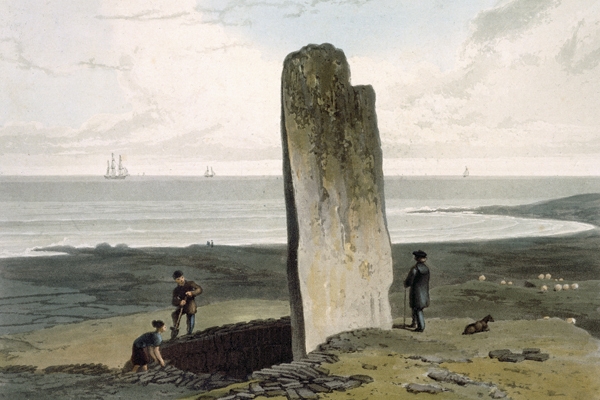Martin Palmer is without doubt one of our leading authorities on the subject of Nature and sacred writing today — among his previous publications being Sacred Gardens and The Sacred History of Britain. One of the primary aims of his latest book is to teach us how to ‘read’ our surroundings; for, he believes, like all sacred art, Nature can be read as a book, if only one understands the language. Thus, through ‘decoding’ the towns, villages and countryside of Britain, we may come to see that ‘we are caught up in a part of something much greater and grander than ourselves’.
The first half of the book covers ‘the beliefs and stories that have shaped the landscape of Britain’, in which Palmer explains what he means by the sacred and why it is important for us to be aware of it. He guides us from pre-history to the present through long barrows, standing stones, islands, caves, groves, wells, battlefields and hills, taking in prevailing winds, the evolving shape of fields, the significance of place names and the orientation of villages and towns, with their festivals, market crosses and burial grounds.
The second half of the book, with its useful gazeteers, is more of a guide to specific sites and how to interpret them from a spiritual perspective. Palmer discusses, among many others, Bardsley Island, St Winifred’s Well, the Anglo-Saxon church at Bradford-on-Avon, with its sunken, rather than raised, altar, and the ancient yew in Fortingall churchyard (Perth and Kinross), which pre-dates by hundreds of years the medieval church built beside it.
As always, he is a mine of knowledge and inspiration. We learn that the names Thames and Tamar derive from the Sanskrit word tamasar, meaning ‘dark river’ (the river Tamasar itself being a tributary of the Ganges, India’s most sacred river); that Stonehenge, though popularly associated with the Druids, almost certainly predates them, and in its scale and grandeur was the exact antithesis of what they believed in; and even that keepers of taverns called ‘The Bull’, post-Reformation, were at pains to depict the animal clearly on their inn signs, for fear of any associations with a Papal Bull.
A chapter entitled ‘Walking on the Dead’ is an especially absorbing study of our relationship with death over the centuries. ‘When, today’, Palmer writes, ‘flowers are left at the scene of a fatal accident, they replicate the old wayside shrines of pre-Reformation Britain.’ He reminds us that three catastrophic plagues — in the sixth century, as well as the Black Death and the plague of 1665 — wiped out a vast proportion of the population: ‘Across England, there are hundreds of plague pits that we walk over in blissful ignorance, because they are no longer marked as places that contain the bodies of thousands of our ancestors’. The oldest known burial site in Britain, and indeed in the whole of western Europe, is in the Gower peninsula, thought to date fromapproximately 33,000 years ago, of a young man placed in the foetal position and painted in red ochre.
Although the environmental crisis, and the problem of how to exist in a sustainable way, are now of universal concern, few people make the vital link between earth and heaven in the way Palmer does. Everything that we see in Nature is, as the Qur’an reiterates, ‘a sign or a symbol of God’. The whole of Sacred Land could be viewed as a commentary on this; for ‘many of us have forgotten — or never knew— how to connect with Nature’, says Palmer.
His profound plea, therefore, is for us to recover the things we have lost; and not just in the landscape, but in everyday objects too — taking pottery as one example. As anyone who has studied traditional cultures will know, pots — the result of mixing the elements of earth, water and fire — ‘were not merely vessels that were used to contain other items … not just a useful consumer product, but a sign of divine significance and meaning.’Even today, although we may not view our morning cup of coffee as an ‘offering to the gods’, the ‘enduring mythology’ of the Holy Grail continues even in ‘the passion and prayers that are generated every year by the FA Cup — a pot by another name’.
Crucially, Palmer lives what he writes, having founded several charities to promote the protection of the countryside. His book is no dry academic tome, but the result of deeply felt experience and the accumulated knowledge of a lifetime.
And he has a gift for conveying this to ‘whoever has eyes to see’.
While I regret that there is no bibliography, which is frustrating, and the footnotes are strangely incomplete, Sacred Land is a profound elegy on the true nature of our landscape as well as being a timely reminder that we should ‘walk more gently upon the face of the earth’. I was profoundly moved by it, and I hope other readers will be too.






Comments